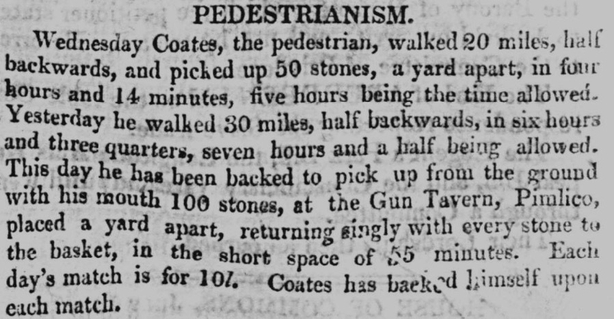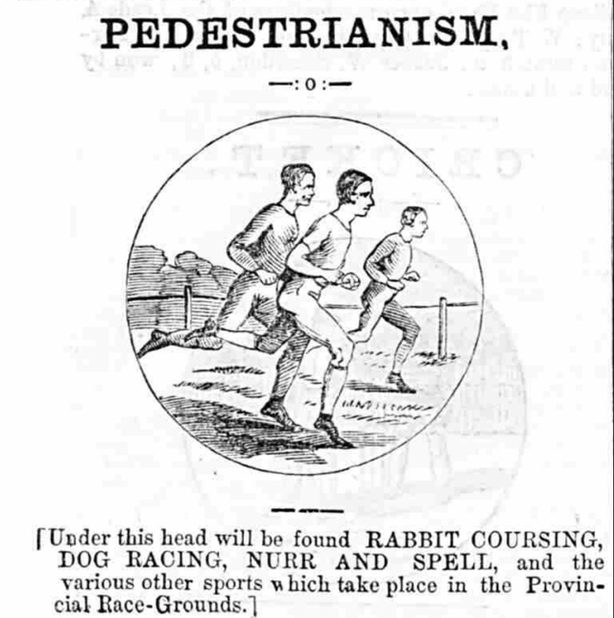Analysis: Robert Coates attracted thousands of spectators when he took part in various sporting events in Dublin in 1835
One of the most interesting and satisfactory elements of historical research is finding an event which occurred in the past yet is not recorded in local, popular or academic history. One such historical nuggets was the arrival of Robert Coates 'the pedestrian' in Dublin in the 1830s.
The vast majority of sports became associated, that is organised, in the late 19th century. Soccer, rugby, cricket, Gaelic games and athletics, among many others, obtained rules and governing bodies. Like other sports, athletics had earlier events such as ‘pedestrianism’. This is where individuals competed against the clock or the calendar in endurance events lasting from an hour to several months in an attempt to win a purse created from wagering, or gambling.
British and Irish newspapers of the time followed the extraordinary and sometimes bizarre feats of these individuals with great interest. The father of ‘pedestrianism’ or later race-walking was Captain Robert Barclay, a Scot who captured the British public’s imagination when he walked a mile (1.6 km) in each of 1,000 successive hours to win a wager of 1000 guineas between June 1st and July 12th 1809 at Newmarket.

But Robert Coates would surpass this achievement. Coates was born in London sometime at the turn of the 19th century. Five feet ten inches tall with an athletic build, he was also a teetotaller with a ferocious appetite for food. Coates' career as an amateur pedestrian spanned at least 27 years from 1827 to 1855. The first report of Coates within the newspaper archives appears in 1827. The Berkshire Chronicle reports on Coates’ attempts to pull a sofa for a full mile; run forwards a mile; run backwards for half a mile, trundle a hoop for a mile, row a boat a mile and walk a mile, all within 60 minutes beginning on Waterloo Bridge. Coates failed by one and a half minutes.
The following year, Coates walked 50 miles over a consecutive three day period, half of it backwards within an 11 hour time period, thus beating his allotted time by almost 90 minutes. On the final day of these events at the Gun Tavern in Pimlico, London, Coates picked up 100 stones, each placed a yard apart, and deposited each one in a basket from his mouth in under 55 minutes. In the same year he broke the previous record of Captain Barclay.
In October 1835, Coates arrived in Dublin, where he performed several feats in the Rotunda gardens for a crowd before announcing his plan to run and row all of the bridges on the River Liffey within the city. The announcement proclaimed that Coates would run from Carlisle (O'Connell) Bridge to Kings Bridge (Heuston Station) crossing each of the eight bridges as he ran. On arriving at Kings Bridge, he would descend into a boat and row his way back to Carlisle Bridge weaving around each arch of every bridge on the way back. The time set for the wager was an incredible 40 minutes.

Great excitement was recalled in the newspaper reports. Thousands of spectators rooting for Coates to succeed lined north and south quays of the Liffey. Arriving at Kings Bridge, Coates climbed on board his custom designed two oar skiff, painted black and adorned on each side with skulls (whether these were human or animal was not declared).
Coates' undoing was that he got stuck in the bloody mud, literally. After negotiating 'Bloody Bridge’ at Barrack Street (Collins Barracks today), Coates' boat became stuck in the mud of the low tide and he lost valuable time in trying to retrieve one of the skulls which had fallen into the water. He completed his task, but two and half minutes over time, much to the disappointment of the crowd.
He returned within a year and won another crowd pleasing event. This time, he completed the same event with the addition of a 100 hurdle dash at the entrance to the Phoenix Park in just under 60 minutes. Coates came back in Dublin again in 1856, when he walked 500 miles in 500 hours over 21 days earning himself a gold watch and fifty guineas.

Coates carved out a career backing himself on wagers of long distance endurance walks, usually 1,000 miles. His habit was reportedly to sleep for 20 minutes out of every hour, springing back up after each mini sleep and continuing on his way. Newspapers reported that this was the only sleep he took when on a challenge. In 1841, Coates ran and won a 100 hurdle race against a horse, specially trained for the event.
These events often took on gruelling physical proportions while the participants were forced to sleep in the open and were subject to dreadful weather conditions. On some of his challenges, Coates was accompanied by colleagues who looked after him. During a 1,000 mile walk in 1853, he was accompanied by two medical men who were concerned for his health. Sleeping and walking in the constant wind and rain had apparently taken a toll, and one newspaper reported how his appearance had been altered.
But the weather and tiredness were not the only hazards an amateur athlete faced. Two months into a walk from Glasgow in 1851, Coates reported to having been drugged by two strangers who offered him brandy, a ploy he felt was set up by someone who had bet against him and his challenge.
Age showed no sign of slowing down the career of Coates. In 1854, he travelled to Paris to take part in pedestrian events, while in the same year he was backed for £150 to walk 1,000 miles within a minimum limit of 15 minutes per mile. The following year, he was commissioned for a wager by a wealthy army officer to walk 125 miles and row a boat 125 miles within six days.
In April 1855, The Era reported that Coates was alive and residing in Exeter. After this, 'Coates the pedestrian disappeared from the newspaper trail, exited the stage and faded into historical obscurity. Until now, that is....
The views expressed here are those of the author and do not represent or reflect the views of RTÉ







